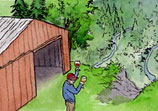
 Landforms in the Ozark Highlands appellation fall into three types: cedar forest, rolling native prairie, or stream bottoms. A unique combination of these features has allowed many prime acres of grapes to thrive here. The area is unusually dry for Missouri, but the brown sandy loam soil atop yellowish clay stresses the vines while holding needed moisture. No less than four rivers cross the area, along with several smaller streams. The appellation’s boundaries form a shape reminiscent of spilled wine, running down the map from east of Jefferson City almost to Eleven Point River. Two large sections of the Mark Twain National Forest form the east and west boundaries.
Landforms in the Ozark Highlands appellation fall into three types: cedar forest, rolling native prairie, or stream bottoms. A unique combination of these features has allowed many prime acres of grapes to thrive here. The area is unusually dry for Missouri, but the brown sandy loam soil atop yellowish clay stresses the vines while holding needed moisture. No less than four rivers cross the area, along with several smaller streams. The appellation’s boundaries form a shape reminiscent of spilled wine, running down the map from east of Jefferson City almost to Eleven Point River. Two large sections of the Mark Twain National Forest form the east and west boundaries.
Vines were first planted here by Italian immigrants, and native cultivars and French hybrids continue to grow. The area’s fruit wines are also very worth a taste. The Ozark Highlands is a peaceful area where cows look up as you drive by and where winemakers are usually the winery owner. The label outside the bottle might be a little crooked, but the wine inside might be the finest varietal expression or blend balance you have tasted.
~ Tim Pingelton, Missouri Editor
|
|
Current Feature
In the southern Blue Ridge Mountains of North Carolina and Georgia vineyards are small and few, yet the establishment of the Upper Hiwassee Highlands could bring much more.
[>] continue
Appellation Features
[>] see all Ozark Highlands features (1)
Related Features
Alive & Well here

Norton | Cynthiana:
Your history is crazy, even a little wild. You first surfaced in the state of Virginia as Mr. Norton,
[>] continue
Correspondent
 Tim Pingelton
Tim Pingelton
is the Regional Correspondent for Ozark Highlands.



 Bi-State Upper Hiwassee Highlands an AVA
Bi-State Upper Hiwassee Highlands an AVA  A Wine Rite-of-Passage
A Wine Rite-of-Passage Remote Manton Valley New California AVA
Remote Manton Valley New California AVA WAWGG Banquet Explores Washington State Terrior
WAWGG Banquet Explores Washington State Terrior Taking Focus on Appellation
Taking Focus on Appellation Whitehall Lane Winery, A 20 Year Story of Vineyards
Whitehall Lane Winery, A 20 Year Story of Vineyards Embracing Virginia’s Terroir
Embracing Virginia’s Terroir  Appellation America to Drop Paywall - Provide Open Access
Appellation America to Drop Paywall - Provide Open Access Shake Ridge Ranch - Gem of the Sierra
Shake Ridge Ranch - Gem of the Sierra


.jpg)